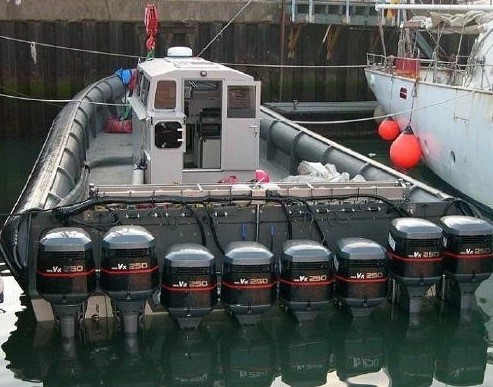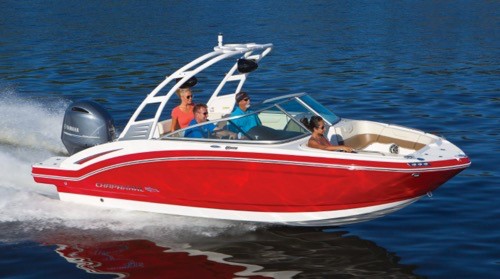Which is Best: A Single 300 or 2x 150s?

Is it better to carry one big engine or two, or more, smaller ones?
This is easy to answer — in theory anyway. In most cases, a single-engine boat will go faster than a multi-engine boat with the same total horsepower. Why? One engine weighs less than two, and more weight means the boat is harder to push with the same horsepower. One engine, with one prop, also creates less drag than multiple props, and drag is also a detriment to speed.
Having said that, we have tested boats that actually seem to go slightly faster with twin 150 outboards than with a single 300. We assume this has to do with total prop blade area and therefore greater lift. In any case, in this example, two smaller twins always burn slightly more fuel than a single.
Certainly, there are advantages to two or more engines, including better handling, added redundancy (especially important to folks who fish or cruise far offshore), and increased reliability with easier maintenance (one high-hp engine, especially a gas engine, may require more maintenance and hand-holding than two smaller ones). On the other hand, a single engine is less costly to buy, operate, and maintain -- and, in our opinion, fun on the water isn't relative to the number of engines.

One downside of single-screw that's often overlooked is torque steering. That's the tendency of the boat to veer from her straight course because of the propeller "walking" one way or the other. Props walk because the water at the bottom of their rotation is slightly denser than near the surface; when the prop blades hit the denser water, they tend to push sideways against it, a force that's not countered by a similar effect at the top of the rotation where the water's density is thinner. Torque steer is more pronounced when backing, thanks to hydrodynamics, but can have an effect when moving ahead, too.
Is Redundancy Necessary? When or Where?
Other than the torque-steering issue, the biggest reason to have two smaller engines instead of one large one is redundancy. But when and where is redundancy really necessary? The boating world has changed a lot in the last 20 years, and even in the last 10. With the advent of towing services like Sea Tow and BoatUS, there are boats waiting on 24-hour calls in most areas of the U.S. where there are a lot of boats on the water. If an engine fails in these areas, a $350 - $500 tow is a lot cheaper than a second outboard engine.
Obviously, boaters going far offshore or into areas where there is no reliable towing service is another matter entirely. There, a second engine can pay off.
Outboard engines are much more reliable than they once were. The advent of fuel injection, anti-vapor lock devices, and digital software have greatly improved outboard engines over the years. Our experience is that the most vulnerable aspect of an outboard engine these days is the software itself. If the CPU overheats or blows, engine shutdown can, and usually does, occur. There is also the chance that the smallest part in a critical area could fail and bring the engine to a halt.
Our conclusion is that the selection of twins or a single engine is more a matter of where one wants to go. Most people boat on lakes or close to shore and within VHF range. For them, a failed engine is just an inconvenience and a few hundred dollars, and in the big scheme of things, no big deal. For those going offshore, it is another matter.